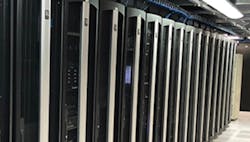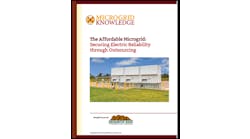The Five Pillars for Successfully Deploying Networks in Edge Locations
Sam Rodriguez, Senior Product Manager for Industrial Solutions at Chatsworth Products offers five steps to ensure your edge network will be set for success.
Sam Rodriguez, Senior Product Manager for Industrial Solutions at Chatsworth Products
The rise of the Internet of Things (IoT) and the rollout of next-generation cellular wireless technology are requiring network connections to be stretched beyond the boundaries where electronics are normally deployed. Today, a soaring number of smart devices are processing real-time data at the edge—typically harsh or nontraditional environments, such as manufacturing floors, campus sites and outdoors
These edge locations are the opposite of the environmentally controlled facilities where network connections tend to reside, such as data centers. They include varying conditions such as heat, snow, humidity, rain, corrosive agents and dust. As a result, deploying compute and automation control equipment in these environments requires innovative methods of storage, support and maintenance.
Because they exist in remote and extreme environments, edge networks are not administered or overseen daily. Like the proverbial chain that is only as strong as its weakest link, any limitations on network design, infrastructure or performance might result in unacceptable downtime.
That’s why environmentally rated enclosures with cooling accessories, and cable and power management solutions play a key role in enabling network operations at the edge.
The interesting thing about the edge is that it encompasses all the elements of a data center deployment. You must deal with thermal management, remote monitoring and control, security, and know the environmental conditions within the enclosure. More importantly, you must address the environment where the enclosure will be located. Edge enclosures are the first line of defense for your sensitive and expensive equipment.
Following are five important considerations for information technology (IT) and operational technology (OT) teams to include in the planning of a robust and reliable network at the edge:
- Consider the Environmental Conditions
Harsh weather conditions such as heat, snow, humidity, precipitation and corrosive environments require equipment to have higher levels of protection. In nontraditional spaces, the enclosure provides the primary protection for equipment. The main difference between industrial enclosures and standard IT enclosures is that industrial enclosures are completely sealed when closed (see Figure 1).
In the United States, the National Electrical Manufacturers Association (NEMA) identifies 16 types of enclosures for nonhazardous locations, each providing a different level of protection against dust and liquid penetration, in its “NEMA Standard 250 Enclosures for Electrical Equipment (1,000 V Maximum).”
Underwriters Laboratory (UL) has a similar system in “UL 50 Enclosures for Electrical Equipment, Non-Environmental Considerations; UL 50E Enclosures for Electrical Equipment, Environmental Considerations; and UL508A Standard for Industrial Control Panels.” The difference between NEMA Type and UL Type is that manufacturers can self-certify NEMA Type enclosures, but UL Type enclosures are verified by UL through a series of design review and performance testing.
Table 1: NEMA Type ratings for enclosures used in indoor nonhazardous applications
Table 2: NEMA Type ratings for enclosures used in outdoor nonhazardous applications
When specifying an industrial enclosure, select vendors that can provide the following features and capabilities:
- Third-party certification: UL Type protection rating
- Robust construction: Fully welded, steel construction
- Precision: Robotically applied, continuous foam gaskets
- Configurability: Multiple styles and sizes covering a wide range of applications
- Customization: On-demand modifications (size, openings, color, accessories and more)
- Personalization: Modified to blend or match surroundings
- Consider Security Vulnerabilities
Equipment placed in remote edge locations is likely to be more vulnerable to rogue attacks and vandalism because these locations have minimal or zero personnel. It is important to invest in a comprehensive physical security solution that can be easily integrated into your edge enclosure. When planning for physical security, be sure to:
- Plan for multiple layers of security
- Ensure data produced at the edge remains private and secured
- Ensure only authorized people have access to equipment, and deploy an access control system with alarm notifications
- Maintain an automated logging method of who and when the equipment was accessed
- Protect non-authorized users from being electrocuted
RMR Freestand Install (Photo: CPI)
Properly planning and deploying such infrastructure can be a monumental task. For a successful edge investment, partner with suppliers who can provide customizable, scalable and environmentally rated solutions that can support and protect new-generation equipment.
- Consider Equipment and Cabling
How will you prevent network damage? Traditional OT applications used to rely on back plates and DIN rail-mounted equipment, plastic wire ducts for electrical wiring, etc. Switches and servers, on the other hand, require 19” rails, copper and fiber media, 48-port patch panels, etc. The equipment has different airflow requirements, and copper and fiber-optic cable require different styles of management.
There are two universal concerns and solutions regarding cable management in manufacturing environments, as follows:
- Limited floorspace. the manufacturing environment is reserved for manufacturing equipment and second for material logistics. Overhead may be the best option for network cabling, offering the least obstructed path for cables, and being high enough to avoid incidental damage from material handling
- Need for flexibility. manufacturing equipment and floorspace changes are reset to new configurations in a continual process. Additionally, as an organization increases the amount of integrated automation, faster network connections are required to keep equipment connected and synchronized correctly. Zone cabling is the practice of dividing the space into zones and supporting connections in each zone from a centralized telecommunications enclosure. This allows easier moves, adds and changes and typically limits cabling and networking changes within the affected zone.
- Consider Thermal Control and Management
The sealed design of industrial enclosures does not allow for needed ventilation, so a filter fan or cooling unit is an important requirement to exhaust or reject heat from the enclosure in order to maintain the equipment manufacturer’s recommended temperature operating range.
Like the enclosures, the filter fan or cooling unit need to be IP- or NEMA-rated to match (or exceed) the enclosure rating. Filter fans draw filtered air into the enclosure and exhaust air through a matched filtered exhaust or a second filter fan.
Cooling units mount through the door, top or side of the enclosure and provide closed-loop cooling. The cooling unit has independent internal and external air paths, so air does not enter or exit the enclosure. The cooling unit circulates air within the enclosure, rejecting heat to the outside of the enclosure through an air conditioning circuit.
To address efficiency, industrial cooling units typically have a fixed set point and circulate air continuously. The compressor cycles off if the temperature within the enclosure is under the threshold, but the fans run continuously at a constant rate. It is important to size cooling units for a specific heat load to match the sum of the heat produced by the equipment in the enclosure. If the enclosure supports mission critical equipment, a redundant cooling unit should be added. The redundant units should be linked together so they can be cycled at partial load or run concurrently if peak load exceeds a single unit’s capacity.
RMR Custom Cabinet. (Photo: CPI)
When selecting thermal management accessories for industrial enclosures, select vendors that can provide solutions that are efficient and scalable.
- Consider Remote Monitoring Capability
To ensure environmental conditions remain optimal for equipment and to detect changes in the environment or signs of tampering, consider adding electronic monitoring and control inside the industrial enclosure.
Environmental monitoring appliances such as intelligent power distribution units (PDUs) and environmental sensors can measure temperature, humidity, airflow, power, intrusion and detect entry of water.
PDUs distribute power to switches, provide remote outlet control so you can remotely cycle power to equipment, and monitor power use by equipment. Some PDUs also monitor environmental conditions. Both devices automate monitoring, keep logs of measured data and let you set thresholds and receive alarm notifications when conditions approach limits, so you can prevent network outages.
When procuring power and environmental management solutions, look for vendors that can provide features such as high temperature rating (at around 149° F (65° C)) and a wide range of models including monitored and switching capabilities.
Final Thoughts
When placing equipment into spaces such as warehouses, manufacturing floors and outdoors, select an industrial enclosure with appropriate environmental protection ratings; address thermal requirements by adding a fan or a cooling unit that matches the enclosure protection rating and equipment cooling requirements; and use a cable entry system that will maintain the enclosure rating by completely sealing around cables. Finally, consider remote monitoring and control to ensure the environmental conditions match equipment requirements and to monitor and cycle power to equipment without opening the enclosure.
Sam Rodriguez is the Senior Product Manager for Industrial Solutions at Chatsworth Products





